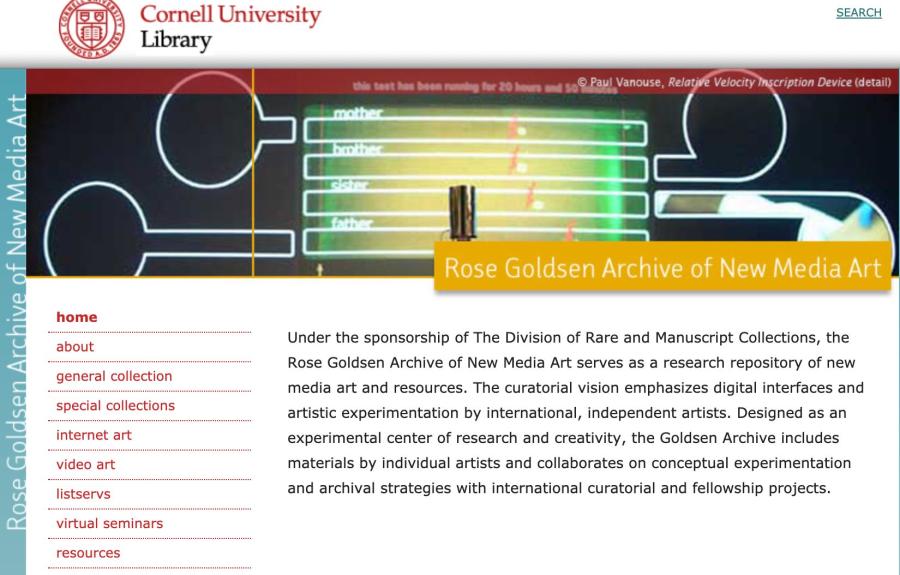
Named after the pioneering critic of the commercialization of mass media, the late Professor Rose Goldsen of Cornell University, the Rose Goldsen Archive of New Media Art was founded in 2002 by Timothy Murray to house international art work produced on CD-Rom, DVD-Rom, video, digital interfaces, and the internet. Its collection of supporting materials includes unpublished manuscripts and designs, catalogues, monographs, and resource guides to new media art. Meant to carry on the collaborative and amateur legacy of the rise of electronic and new media art, the Goldsen Archive focuses on including materials by an expansive range of emergent international artists and art centers and collectives, such as ZKM, Anarchive, subRosa, Dongtai Academy of Art in China, and Experimental Television Center. Designed as a center of research and creativity, the Goldsen Archive emphasizes broader sets and networks of artworks and ephemera grouped around media genre and international sponsor, such as the 400 dossiers of American artists nominated for the Renew Media/Rockefeller Foundation Fellowships in New Media, the 8,000 digitized images of Taiwanese installation and new media art in the Yao Jui-Chung Archive of Contemporary Taiwanese Art, Wen Pulin’s 360 hours of digitized video of contemporary Chinese art, the 3,000 titles of video art in the collection of the Experimental Television Center, the extensive archives of net.art from Computerfinearts.com, Turbulence.org, and CTHEORY Multimedia, the archives of the New York State Council on the Arts’ competition in Electronic Media and Film, and soon the emergent archives in bioart of Beatriz da Costa and the AI robotics of Ken Feingold. Goldsen also collaborates on conceptual experimentation and archival strategies with international curatorial and fellowship projects, from the Taishin Bank Foundation for Arts and Culture in Taiwan and Fundacio Telefonica of Buenes Aires to the New York Foundation for the Arts, National Endowment for the Arts, and the National Endowment for the Humanities in the US.
Among archive-sponsored pedagogical initiatives are its hosting of pioneering media artists and A. D. White Professors-at-Large Lynne Hershman Leeson and Xu Bing, its initial hosting of the Rose Goldsen Virtual Seminars, which permitted Cornell seminars and workshops to conduct online webstreaming with international colleagues, and its ongoing hosting of the international new media listserv, -empyre- a soft_skinned space, managed by Cornell faculty member, Renate Ferro.
Nurtured as much as a platform of creative and scholarly networking as a venue of media object preservation, Goldsen’s emphasis has consistently been more on the spontaneous inventiveness of media networks than on the confident preservation of individual objects. Even as pressures on preservation and access themselves have occupied more of Goldsen’s attention, our unusual strategy, distinguishing us from our peers’ emphasis on preservation of individual “media objects,” has been to emphasis broad preservations of genres, networks, and online discourses rather than highly prioritized individual artists or objects. So, rather than preserve a small set of media objects by featured artists, as pursued by the Whitney, Walker or Berkeley Museums of Art, Goldsen has won grants to provide access to large swaths of media genre and discourse, from CD-Rom art and net.art to online listservs and funding opportunities. Thus, key to Goldsen’s philosophy is the orientation of electronic art and new media around collaborations and networks in way that might challenge the premises of object ontology itself. Goldsen’s homepage thus rotates artworks on its banner in way that stages these works’ emphasis on networks, discourses, and social movements via electronic and digital media.
Tim Murray is a theorist and curator of new media and contemporary art and Director of the Cornell Council for the Arts, Curator of the Rose Goldsen Archive of New Media Art, and Professor of Comparative Literature and English at Cornell University.
